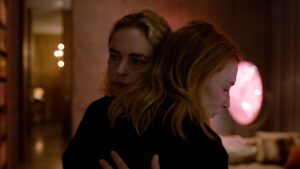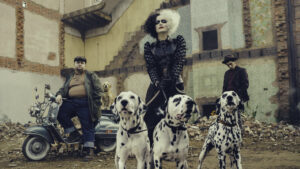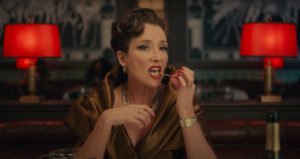MAJOR SPOILERS FOR TÁR AHEAD!
Whoever accepts the Academy Award for Best Actress this year, be it Michelle Yeoh or Cate Blanchett, will ascend to the stage knowing that while it could just as easily have been the other making that same victory-march, they themselves deserved it no less. If, in a staggeringly unfortunate turn of events, it’s Andrea Riseborough, Michelle Williams, or Ana de Armas whose name is instead read aloud from that life-changing envelope, well, they ought to be wondering how they even made it to the ceremony when one of them only started her controversial Oscar campaign in the last few weeks before the nominations were announced, one is essentially committing category fraud when she could have easily beat the competition for Best Supporting Actress, and one is nominated for an unspeakably exploitative Marilyn Monroe biopic that should never have been made in the first place. But it won’t be one of them. It will be, it should be, and it must be either Yeoh for Everything Everywhere All At Once or Blanchett for TÁR.

Blanchett’s nomination for TÁR is her fifth in this category, her eighth in total, and her first since 2015’s Carol. And not since she seeped into the cozy fur stoles of Carol‘s enigmatic titular character has Blanchett immersed herself in a role so wholly with only the slightest physical transformation to facilitate her; yet she deliberately holds her cards close to her chest, remaining so curiously plain, unintimidating, and approachable throughout the film’s opening sequence (which takes the shape of a long, deceptively monotonous sit-down interview with The New Yorker‘s Adam Gopnik) that the audience is made to feel embarrassed, even childish, for being at all apprehensive of her quaint sophistication or for detecting a hint of an edge in her voice when the conversation strays in a direction she doesn’t like. She looks like Blanchett, dresses like Blanchett, and perhaps most crucially of all, talks like her, with an eloquence that would probably come across as pretentious if her delivery wasn’t so merry that the listener is left feeling smarter for hearing her speak and eager to hear her again.
It’s only as you inch closer, close enough to discover that her eyes are eerily devoid of any merriness, that it will finally dawn on you, much too late, why Blanchett was cast and why director Todd Field wouldn’t have made the film without her. The very qualities that endear her to her fans, her approachability and mesmerizing manner of speech included, are qualities that continue to be abused by celebrities (and by virtually anyone on or adjacent to the uppermost levels of the hierarchy in their respective industry), and Blanchett demonstrates for us in the first few minutes of TÁR by creating an atmosphere that feels safe, luring an entire audience in within arm’s length of the fictional-yet-familiar monster inhabiting her skin, and waiting until the cameras are no longer recording to drop the act and dig her claws into her prey. From that moment on, Blanchett is gone, subsumed into the character of Lydia Tár.
Tár, a world-renowned conductor and composer preparing to close out a long career throughout which she has accumulated an almost hyperbolic number of prestigious accolades and awards, including the coveted combination of an Emmy, Grammy, Oscar, and Tony Award collectively dubbed the EGOT, is a character who stands stubbornly with one foot on either side of the boundary between blunt Caricature of a subject, and nuanced Commentary on that selfsame subject – the subject in this case being every celebrity who’s been hearing a lot of stuff about “cancel culture” in the news recently and knows they would hate it if it happened to them, but isn’t online enough to know that it’s a complete and utter fabrication of the far-right: an imaginary war being waged against the authors of badly-written children’s books and offensively unfunny comedians, by some hypothetical mob of angry young people indoctrinated by the left. Lydia Tár probably isn’t the type of person to publicly align herself with the far-right voluntarily (she strikes me as a moderate liberal), but the exaggerated threat of “cancel culture” is too great for her to stand idly by, and in acting frantically to defend herself against an invisible foe she accidentally exposes her own “cancelable” offense – her history of coercing her students into trading sex for job opportunities and blacklisting them when they broke up with her, driving at least one woman named Krista Taylor to suicide.
It should come as no shock to anyone that this was the true purpose of “cancel culture” all along – to make vocal right-wing allies out of those in the arts who would otherwise have kept their mouths shut, and to convince the general public that buying their books, their music, their movies, or tickets to their shows, is tantamount to a victory against the online mobs trying to “restrict free speech” and therefore a moral obligation for the consumer. But what the right-wing doesn’t state out loud is that they pick and choose which “victims” of “cancel culture” to throw a lifeline. And Lydia Tár, a married lesbian and a classical musician, is expendable as far as the right-wing is concerned. Which is how she ultimately finds herself conducting an orchestra at a Monster Hunter game convention in the film’s final scene.

This stunning moment can be variously interpreted as the first of many humiliating low-points in Tár’s career following her fall from grace or the first necessary step in her scrabble back up the social ladder – and then, of course, there’s the distinct possibility that it is Tár herself who has contrived this bizarre, self-flagellating sequence to cap off the fictional narrative she’s been constructing in her head throughout the film, one in which she’s the victim of vaguely supernatural powers out to get her. It occurred to me that Tár is so desperate for a taste of “cancel culture” that it’s possible she’s been fantasizing about Krista’s accusations jeopardizing her career all along. In fact, prior to the outrageous third act, who else besides Tár’s personal assistant Francesca (Noémie Merlant) even knows the details of her inappropriate relationship with the conductor? Francesca, who disappears without a trace – almost like a specter herself – after being passed over for the job of assistant conductor, perhaps causing the increasingly paranoid Tár to retroactively invent reasons to fear her?
As Tár spirals out of control with dizzying speed, whether literally or all in her imagination, she gradually becomes aware that she has fallen out of the carefully-curated biopic she had hoped TÁR would be, and into a grotesquely claustrophobic dark comedy from which there is no escape. Everywhere she turns, she is confronted by demons mundane from one angle, nightmarish from another under Florian Hoffmeister’s lens – the neighbor in the upstairs apartment who won’t stop banging on her door pleading for assistance with her elderly mother; the monstrous black dog that watches her stagger down dimly-lit underground corridors in panicked pursuit of Olga (Sophie Kauer), the mysterious Russian cellist she begins wooing midway through the film; household objects vanishing and turning up in places they don’t belong, like the work of a poltergeist. This string of events culminates in an incident where Tár storms onstage during the live performance of Gustav Mahler’s Symphony No. 5 and physically assaults the conductor standing in for her, eliciting gasps. It’s simply too ridiculous to really be happening…right?
There is only one character besides Tár herself who can escape being ushered to the back row or ejected from Lydia Tár’s self-serving autobiography entirely until the final third, and that is Sharon Goodnow (Nina Hoss), Tár’s indispensable wife, whom the composer dejectedly returns home to after Krista abandons her and Olga leaves to party with her own friends, not for any lingering love but for a potent reminder that she controls Sharon (at least in part by deliberately mismanaging her wife’s medications and then feigning concern over her “absent-mindedness”). Her own sense of security, necessary for surviving in an insular world, starts to rely on her wife remaining gaslighted into believing she’d be hopeless on her own, that she needs Tár to keep her safe from herself. But when details of Tár’s infidelity come out, Sharon finally breaks the fraying thread tethering her to the woman she loved once and escapes with the couple’s young daughter.
And in so doing, Sharon deals a fatal blow to Tár’s confidence – not only depriving her of the precious pair of good-luck charms that the conductor would have happily carried around with her from place-to-place until retirement, but forcing her to confront the dark alone for the first time in her life. Like most predatory people, Lydia Tár doesn’t know how to function without someone “weaker” alongside her to reassure her that she’s the strongest person in any room, and she doesn’t enjoy the sensation of being on equal footing with anyone (personally or professionally), yet she also becomes sick to her stomach when she is bluntly offered her choice of sex-workers in a Southeast Asian country toward the end of the film. She runs away, offended at the suggestion that what she’s been doing all her life is anything like that.

But ultimately it doesn’t matter, because in that final scene where Tár once again takes the stage to conduct an orchestra for an enraptured audience, Field forces you to sit with the uncomfortable realization that whether or not this is all really happening, even in Tár’s worst nightmares she is still working. It may not be work she relishes, and she’s probably wincing inside as she hears her distinctive sound swallowed up by Monster Hunter‘s electronic score, but she’s still onstage, bathing in the spotlight, and conducting. Even she must surely recognize then and there that “cancel culture” was and will always be a myth as long as the “canceled” still have a platform from which to complain about it.
Film Rating: 8.9/10


